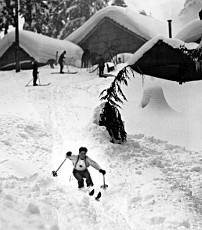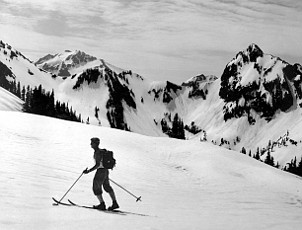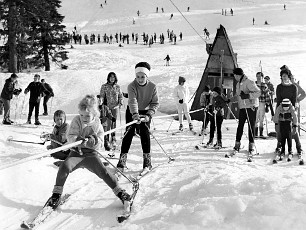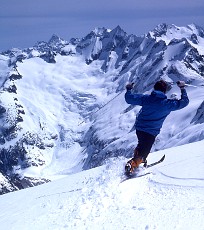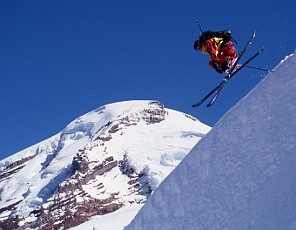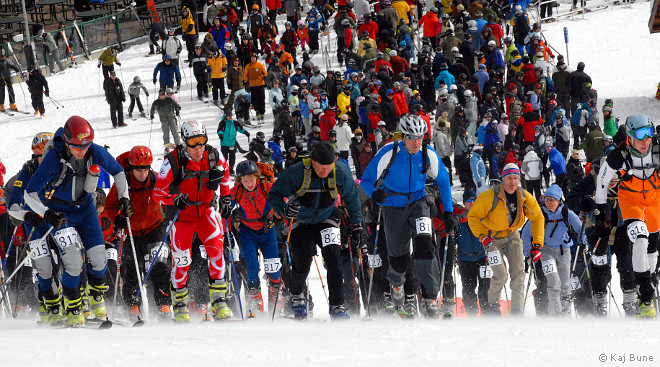 |
|
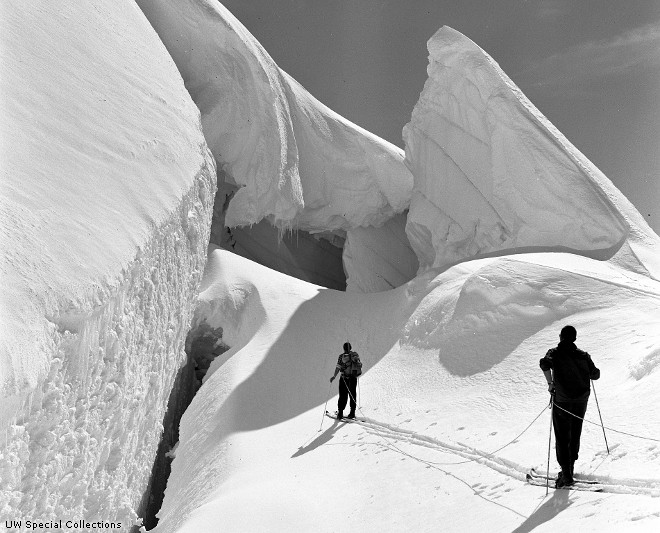 |
|
| Skiers explore the Quien Sabe Glacier in Boston Basin in the 1950s. (Bob and Ira Spring) | |
|
In the early days,
all skiing in Washington was backcountry skiing. There were no chairlifts,
ski patrol, gates, or grooming. Miners and fur trappers started it. In the
1890s, skis were sometimes used to run errands in mining towns or to follow
trap lines in winter. Skis were used for work rather than pleasure in those
days. Skiing for recreation in the Cascades emerged in the first decade of
the 1900s. At Scenic Hot Springs near Stevens Pass and Longmire Springs at
Mount Rainier, hotels were built to accommodate summer tourists traveling by
train. After visitors started to show up in winter, the hotels began stocking
snowshoes, toboggans, and skis to attract more guests through the allure of
winter sports.
In 1914, The Mountaineers built a lodge near Snoqualmie Pass to make summer and winter outings more accessible to club members. Most skiers at that time were self-taught, and controlled skiing was a novel concept. Lawrence Byington of the club recalled that before European immigrants began sharing the secrets of telemark and christiania turns, “We herring-boned up and ran it straight.” Completion of Rainier’s Paradise Inn in 1917 and Mount Baker Lodge in 1927 made it practical to visit these alpine playgrounds in winter. The proprietors, who initially planned for summer use only, gradually responded to the demand for winter lodgings. Within a few years, both Paradise and Mount Baker were full-fledged winter resorts. More club lodges sprang up near Snoqualmie Pass. In 1934, the Seattle Park Board cleared a few acres of forest to create a public ski hill at the site of today’s Summit West Ski Area. A couple of years later, the US Forest Service began developing ski grounds at Stevens Pass and at Deer Park on the Olympic Peninsula. In 1926, William J. Maxwell made one of the earliest recorded ski ascents in the Cascades on Denny Mountain, site of today’s Alpental Ski Area. By the mid-1930s, skiers had encircled Chair Peak, climbed Snoqualmie Mountain, and traversed the Cascade Crest from Snoqualmie Pass to Stampede Pass. At Mount Baker, they had explored the backcountry from Shuksan Arm to the volcano itself. At Mount Rainier, Camp Muir, Nisqually Glacier, Indian Henry’s Hunting Ground, and the Tatoosh Range were all popular tours. But in all of Washington State, not a single rope tow or chairlift yet existed. In April 1928, Hans-Otto Giese, Otto Strizek, and Walter Best introduced ski mountaineering to the Cascades; they skied to 12,000 feet on Mount Rainier, stashed their skis, and continued to the summit on crampons. After returning to their skis, they descended in two-and-a-half hours what had taken them two days to climb. Two years later, Edwin Loners and Robert Sperlin skied to the summit of Mount Baker for the first time. By 1933, skiers had summited Mounts Hood, Adams, and St. Helens. The last of the Washington volcanoes to fall was remote Glacier Peak, which Sigurd Hall and Dwight Watson skied in July 1938.
The 1930s and 1940s brought a surge of ski scouting to the Cascades and Olympics. Skiers explored destinations far from the usual ski centers at Mount Baker, Mount Rainier, and the Cascade passes. Adventurous skiers scouted Mount Pilchuck, Ruth Mountain, Eldorado Peak, North Star Mountain, Whitehorse Mountain, Mount Daniel, Mount Hinman, the Enchantments, the Goat Rocks, and many other isolated peaks. Dwight Watson was the most widely traveled backcountry skier of this period. Skiers also began exploring high-level traverses. In April 1934, Otto Strizek, Orville Borgersen, and Ben Spellar skied across several of the largest glaciers on Mount Rainier from Paradise to the White River. During the same month, Ralph Calkin and James Mount of the Wy’east Club skied all the way around Mount Hood in less than ten hours. In the 1930s, Ben Thompson and Dwight Watson pioneered separate traverses around and over Mount Baker. In 1938, Max Borst led a party from the Deer Park Ski Area along Hurricane Ridge to the Elwha Road in the Olympic Mountains. Afterward he recommended building a series of huts along the route. Like a spring flower killed by a late frost, two events stunted the early growth of backcountry skiing in Washington. First was the introduction of the rope tow. During the 1937-38 ski season, rope tows were installed at Mount Baker, Stevens and Snoqualmie Passes, and Paradise on Mount Rainier. Skiers no longer had to climb to ski, eliminating one of the basic reasons for ski touring. The second event was the outbreak of World War II. Many pioneer skiers were drawn into the war effort, and gas rationing limited the travel of many others. Paradise, the Northwest’s premier ski resort, was closed during the war. Following the war, lift skiing rebounded with vigor, but backcountry skiing did not. In 1946, Fred Beckey proposed to The Mountaineers publication of a climbers’ and skiers’ guide to Washington, with the skiing section to be written by Dwight Watson. After The Mountaineers turned down the project, Beckey published his guidebook through the American Alpine Club, but Watson’s skiing section was left out.
The 1950s and especially the 1960s were boom years for downhill skiing. New ski areas were developed at White Pass, Mount Pilchuck, Hurricane Ridge, Crystal Mountain, Alpental, and Mission Ridge. A few of the old guard lamented that ski mountaineers had become a dying breed. Hans-Otto Giese, one of the earliest pioneers, said in 1969: “People are too lazy now. They’d rather sit on a chair, get hauled up, ski down, and then take the next chair up—just like a yo-yo.” In fact, a small number of skiers kept the backcountry torch aloft during “the dark ages,” as one of them called this era. Bob and Ira Spring, renowned outdoor photographers, organized trips to Mount Rainier, Mount Baker, Glacier Peak, and Boston Basin, returning with classic images that were published in newspaper pictorials. Charles and Marion Hessey of Naches spent weeks skiing and making movies at remote cabins in what are now the Glacier Peak and Pasayten Wilderness Areas. Joe Firey and other Mountaineers explored new ski routes on Mount Shuksan, Eldorado Peak, Snowking, Silver Star, Ruby, Blum, and other remote summits. Yet the backcountry faithful remained few in number. In 1968, The Mountaineers published Northwest Ski Trails, a guidebook filled with photographs by Bob and Ira Spring of ski tours from Mount Garibaldi, British Columbia, to Mount Hood, Oregon. To broaden the book’s appeal, it included maps and descriptions of all the major ski areas in the region. The publishers hoped the book would offer downhill skiers an alternative to the chairlifts, but the book didn’t sell. Most of the growth at that time was in “skinny skiing,” Nordic touring on light cross-country skis.
Cross-country skiing grew in the late 1960s and 1970s as a reaction to overcrowding and the steeply rising costs of alpine skiing. The simplicity and light weight of cross-country equipment was a big part of the sport’s appeal. As cross-country skiers ventured farther from established trails, they rediscovered the telemark turn as a way to maneuver light Nordic skis. Steve Barnett’s 1978 book, Cross-Country Downhill, introduced a new generation of skiers to techniques forgotten since the 1930s. Barnett, with Dave Kahn, Bill Nicolai, and others, began using lightweight Nordic gear to repeat classic routes done before World War II and to explore new skiing challenges like Mount Olympus and the Ptarmigan Traverse. The 1980s and early 1990s were a golden age of ski traverses in the North Cascades, during which skiers established a network of high-level routes from the US-Canadian border to Glacier Peak. The skiers pioneering these routes were using either lightweight telemark equipment or recently developed alpine touring gear such as the Ramer binding. Fred Beckey’s new Cascade Alpine Guide provided photos and inspiration for many of these ventures. The North Cascades Highway, completed in 1972, was revealed as a treasure trove of spring tours and a launching point for many of the longer traverses. Rainer Burgdorfer’s 1986 guidebook, Backcountry Skiing in Washington’s Cascades, was published during this period. The 1980s brought a surge of energy to the sport, but the number of enthusiasts remained small by today’s standards. Backcountry skiing retained an aura of counterculture, the domain of minimalists who made do with finicky equipment. Skis were narrow. Telemark boots were just beginning to change from leather to plastic. Alpine touring boots were either uncomfortable or heavy or both. Alpine touring bindings were generally considered inadequate for fast, hard skiing. A few young skiers were attracted to the steep snow climbs pictured in Fred Beckey’s guidebooks. In the late 1970s and early 1980s, Karl Erickson and Greg Wong skied the North Face of Mount Shuksan and Ulrichs Couloir on Mount Stuart. A party led by Dan Davis skied Fuhrer Finger on Mount Rainier in 1980. A week later, visiting climber Chris Landry skied Mount Rainier’s Liberty Ridge. On Mount Hood in Oregon, Steve Lyford skied many of the classic climbing routes, including Leuthold Couloir, Sandy Glacier Headwall, Cooper Spur, and the North Face. Steep skiers during this period relied on a hodgepodge of equipment. Some used full-on downhill skis and boots, either by fitting crampons over their smooth-soled boots for the ascent or by switching from climbing boots to ski boots for the descent. Others used a combination of downhill gear and early alpine touring gear.
During the late 1990s and 2000s, skis grew wider and more shaped. Manufacturers aimed new gear at resort skiers attracted to the “side-country” by more open boundary policies. Alpine touring bindings became burlier. Telemark bindings added release capability. More and more boot makers offered models compatible with the ultra-light tech bindings popularized by Dynafit. Advances in rescue beacons, survival gear, and avalanche hazard evaluation increased skiers’ confidence about venturing into fresh snow and avalanche terrain. Web discussion forums and videos introduced a new generation of skiers to the attractions of backcountry skiing in their local areas. As the number of backcountry skiers grew, it became possible for ski guides to make a living in Washington, which further accelerated the growth of the sport. Since 2000, skiers and snowboarders have pioneered nearly 200 new ski routes—mostly steep descents, but a few high traverses as well—in the Cascades and Olympic Mountains. A few, but probably not many, of these routes may have been skied earlier. Modern information-sharing not only makes it possible to track these developments but it also fuels motivation as never before. The increased popularity of the sport can be seen in the growth of annual ski mountaineering races. The first local race was held at Alpental in 2002, with three dozen entrants. Ten years later, the number of participants had grown fourfold. Backcountry skiing in Washington is in the midst of an unprecedented period of innovation and expansion. New skiers, new routes, and new ideas make this the most exciting time in the history of the sport. Growth brings both new challenges and new opportunities. Next season you may need to get up a bit earlier to find fresh tracks on your favorite run. But you may also find it easier to venture over the ridge to the special place you have been meaning to explore. Backcountry skiing ignites a passion that is constantly being renewed. Every season, every storm opens a blank page an invites us to trace our storylines anew. —Lowell Skoog
This essay was written for the book, Backcountry Ski and Snowboard Routes, Washington by Martin Volken and the guides of Pro Guiding Service, published by The Mountaineers Books in 2014. |
||||||||||||||||||||||||||||||||||||||
| The Alpenglow Gallery |
